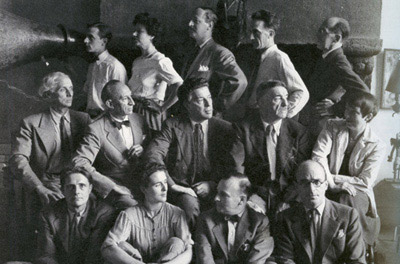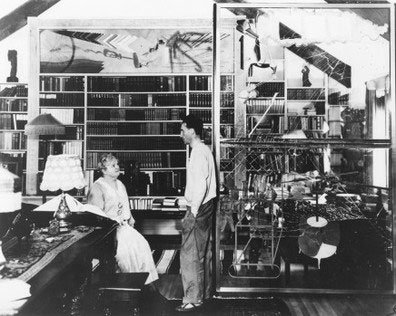Duchamp en de Rothschilds oftewel de Illuminati, in conspiracytermen. Het contact is niet tot stand gekomen via Katherine Dreier (1877-1952) of Walter Conrad Arensberg (1878-1954), in wiens beider collecties Duchamp in belangrijke mate vertegenwoordigd was. Maar de Rothschilds duiken op in de connectie van Marcel Duchamp (1887-1968) met Peggy Guggenheim (1898-1979). Daar zijn de Rothschilds.
Wikipedia;
The Guggenheim family refers to a number of descendants of Meyer Guggenheim who were known for their global successes in mining and smelting (notably the American Smelting And Refining Company), for possessing one of the largest fortunes in the world during the 19th century, and later for their philanthropy in diverse areas such as modern art and aviation, including several Guggenheim Museums as well as the Guggenheim Aeronautical Laboratory and I. M. Pei’s Guggenheim Pavilion at Mount Sinai Medical Center in New York City. The Guggenheim family was a Swiss emigrant family of Jewish ancestry to United States. They sold off their global mining interests following World War I.
Solomon R. Guggenheim (1861-1949) married 1895 to Irene Rothschild (aunt of V. Henry Rothschild II).
Wikipedia;
Peggy Guggenheim was een nicht van Solomon R. Guggenheim, de stichter van de Solomon R. Guggenheim Foundation.
Het Guggenheim Museum New York, officieel het Solomon R. Guggenheim Museum, op 5th Avenue in New York City is één van de vijf Guggenheim museums over de hele wereld naast Guggenheim Hermitage Museum in Las Vegas, het Museo Guggenheim in Bilbao, Deutsche Guggenheim in Berlijn en Peggy Guggenheim Collection in Venetië.
De musea maken alle deel uit van de Solomon R. Guggenheim Foundation.
Peggy Guggenheim reisde in 1921 door Europa, in Parijs kennismaking met Duchamp, levenslange vriendschap. Mogelijk adviserende rol voor Marcel Duchamp.

“Group photograph of ‘Artists in Exile.’” In Peggy Guggenheim’s New York apartment, 1942.
De architect Frank Lloyd Wright ontwierp het Guggenheim (gebouwd 1955-1959) in New York. De dominantie en macht van de elite en de vrijheid van kunst komen hier intrinsiek samen. Smaakvol. Stijl.
De bulk van het werk van Marcel Duchamp is echter elders, in Philadelphia.
Zoals The Large Glass, 1915-1923, in het Philadelphia Museum of Art. Het is bezit geweest van Katherine Dreier, of de Société Anonyme. En in Philidelphia is de installatie Etant donnés: 1. la chute d’eau/2. le gaz d’éclairage.
Het plan van Katherine Dreier was een eigen museum met haar collectie te stichten. Dreier planned to convert her house in West Redding, Connecticut into a museum to house the Société Anonyme’s collection of artwork, in addition to her private collection.
Mogelijk ondersteunde Duchamp Katherine in oppositie met Peggy? Twee nieuwe moderne kunstmusea.
In 1948, Dreier and Duchamp created a catalog of the collection of the Société Anonyme.

‘It was partly because she dared not move the fragile Large Glass monolith, that she had considered converting her home into a Museum. Troubled by the matter even at the end of her life, she confessed to Duchamp that she might not leave enough money to guarantee its upkeep and safety. After her death Duchamp acted as her executor and entered it into the Arensberg Collection in the Philadelphia Museum of Art, which contained most of his works.’
(citaat uit Katherine Dreier and the Société Anonyme, William Clark).
Wikipedia;
Walter Conrad Arensberg (April 4, 1878 – January 29, 1954) was an American art collector, critic and poet. His father was part owner and president of a crucible steel company. He majored in English and philosophy at Harvard University. With his wife Louise (1879-1953), he collected art and supported artistic endeavors.
Website Philadelphia Museum of Art;
‘The Arensbergs became particularly close with Marcel Duchamp, who lived in their apartment during the summer of 1915 while they vacationed at their summer home in Pomfret, Connecticut. They would become the artist’s life-long patrons and form the largest, most significant collection of his work.’
‘… the Arensbergs presented their collection of over 1000 objects to the Philadelphia Museum of Art on December 27, 1950.’
Dreier sterft in 1952 en Arensberg in 1954, het museum Guggenheim (1955-1959) in New York bestaat nog niet. Het lukte Duchamp een groot stuk van zijn werk bij elkaar te brengen in een belangrijk openbaar museum, gefixeerd in plaats en tijd. Een significante prestatie strategisch bij elkaar geschaakt.
Onvoorzien lijkt de impact van de ‘private’ musea en collecties, die zich ontwikkelden tweede helft twintigste eeuw.
De ‘Boite en valise’ in oplage ondervangt het probleem, het eerste exemplaar wordt in 1940 door Peggy Guggenheim gekocht. The large Glass wordt door Richard Hamilton minitieus gekopiëerd.Duchamp sanctioned replicas of The Large Glass, the first in 1961 for an exhibition at Moderna Museet in Stockholm and another in 1966 for the Tate Gallery in London. Richard Hamilton was befriended by Marcel Duchamp. Arising from this Hamilton curated the first and to date only British retrospective of Duchamp’s work, and his familiarity with The Green Box enabled Hamilton to make copies of The Large Glass and other glass works too fragile to travel. The exhibition was shown at the Tate Gallery in 1966.
Duidelijk is de smaak bepalende dominantie van de Guggenheim musea in de twintigste eeuwse kunst. Inmiddels uitgegroeid tot tentoonstellingsmachines met de duurste muren.
Solomon Guggenheim worked in the family mining business, later founding the Yukon Gold Company in Alaska. He retired in 1919 to become an art collector and in 1937 he established the Solomon R. Guggenheim Foundation to foster the appreciation of modern art. He died in 1949.
Aan wie verkocht Solomon R. Guggenheim ‘the global mining business’ na de Eerste Wereldoorlog? Van wie is Yukon Gold?
Het nieuwe produkt is kunst.
Allart Lakke, 27 mei 2010.